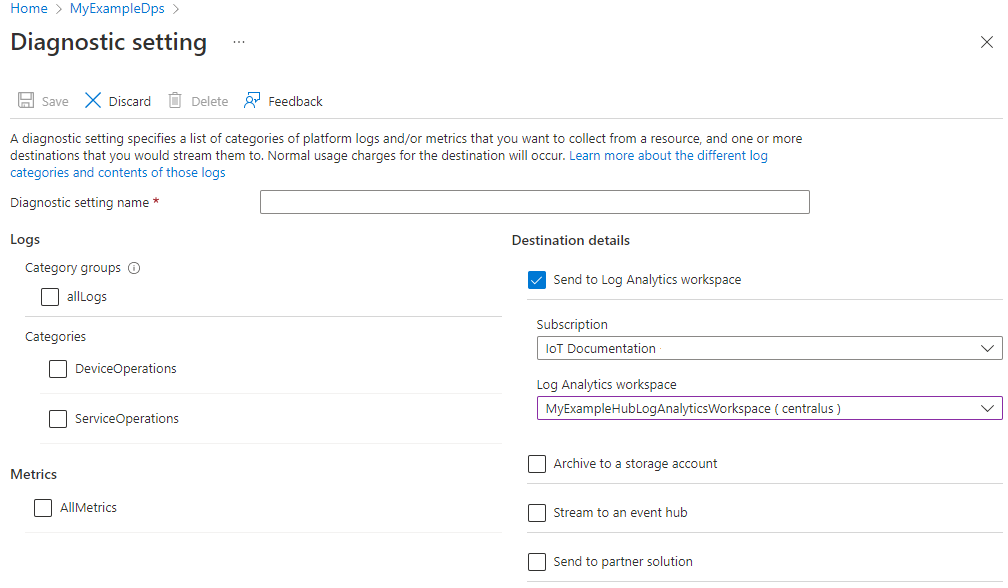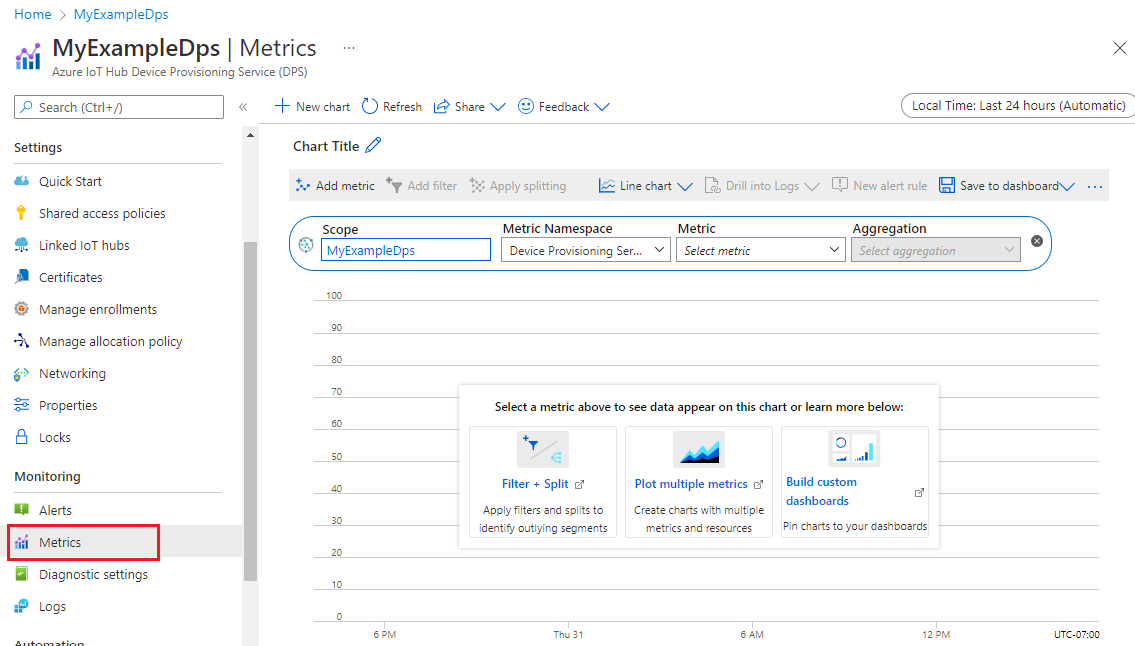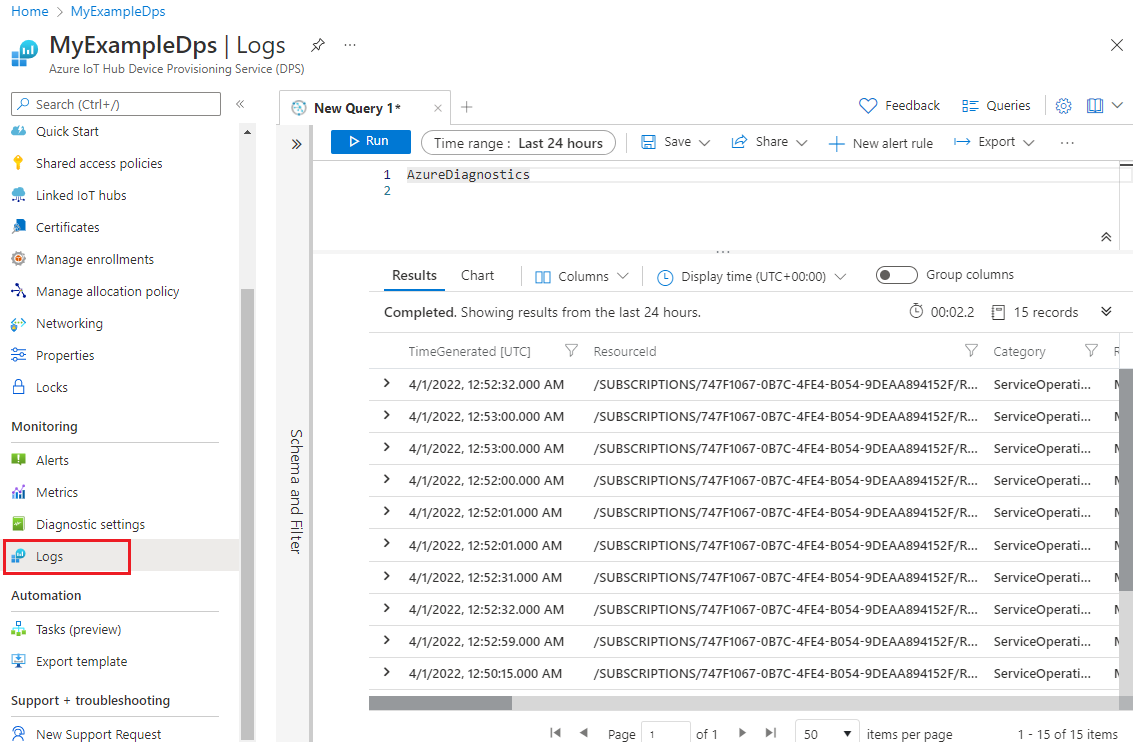Note
Access to this page requires authorization. You can try signing in or changing directories.
Access to this page requires authorization. You can try changing directories.
This article describes:
- The types of monitoring data you can collect for this service.
- How to analyze that data.
Note
If you're already familiar with this service and/or Azure Monitor and just want to know how to analyze monitoring data, see the Analyze section near the end of this article.
When you have critical applications and business processes that rely on Azure resources, you need to monitor and get alerts for your system. The Azure Monitor service collects and aggregates metrics and logs from every component of your system. Azure Monitor provides you with a view of availability, performance, and resilience, and notifies you of issues. You can use the Azure portal, PowerShell, Azure CLI, REST API, or client libraries to set up and view monitoring data.
- For more information on Azure Monitor, see the Azure Monitor overview.
- For more information on how to monitor Azure resources in general, see Monitor Azure resources with Azure Monitor.
This article describes the monitoring data generated by Azure IoT Hub Device Provisioning Service (DPS). DPS uses Azure Monitor.
Resource types
Azure uses the concept of resource types and IDs to identify everything in a subscription. Azure Monitor similarly organizes core monitoring data into metrics and logs based on resource types, also called namespaces. Different metrics and logs are available for different resource types. Your service might be associated with more than one resource type.
Resource types are also part of the resource IDs for every resource running in Azure. For example, one resource type for a virtual machine is Microsoft.Compute/virtualMachines. For a list of services and their associated resource types, see Resource providers.
For more information about the resource types for IoT Hub DPS, see Azure IoT Hub Device Provisioning Service monitoring data reference.
Data storage
For Azure Monitor:
- Metrics data is stored in the Azure Monitor metrics database.
- Log data is stored in the Azure Monitor logs store. Log Analytics is a tool in the Azure portal that can query this store.
- The Azure activity log is a separate store with its own interface in the Azure portal.
- You can optionally route metric and activity log data to the Azure Monitor logs database store so you can query the data and correlate it with other log data using Log Analytics.
For detailed information on how Azure Monitor stores data, see Azure Monitor data platform.
Collection and routing
Resource Logs aren't collected and stored until you create a diagnostic setting and route them to one or more locations.
In Azure portal, you can select Diagnostic settings under Monitoring on the left-pane of your DPS instance followed by Add diagnostic setting to create diagnostic settings scoped to the logs and platform metrics emitted by your instance.
The following screenshot shows a diagnostic setting for routing to a Log Analytics workspace.

See Create diagnostic setting to collect platform logs and metrics in Azure for the detailed process for creating a diagnostic setting using the Azure portal, CLI, or PowerShell. When you create a diagnostic setting, you specify which categories of logs to collect. The categories for DPS are listed in Resource logs in the Azure IoT Hub Device Provisioning Service monitoring data reference.
Azure Monitor platform metrics
Azure Monitor provides platform metrics for most services. These metrics are:
- Individually defined for each namespace.
- Stored in the Azure Monitor time-series metrics database.
- Lightweight and capable of supporting near real-time alerting.
- Used to track the performance of a resource over time.
Collection: Azure Monitor collects platform metrics automatically. No configuration is required.
Routing: You can also usually route platform metrics to Azure Monitor logs / Log Analytics so you can query them with other log data. For more information, see the Metrics diagnostic setting. For how to configure diagnostic settings for a service, see Create diagnostic settings in Azure Monitor.
For a list of all metrics it's possible to gather for all resources in Azure Monitor, see Supported metrics in Azure Monitor.
For a list of available metrics for IoT Hub DPS, see IoT Hub DPS monitoring data reference.
Using Azure Monitor to view metrics and set up alerts
To view and set up alerts on IoT Hub Device Provisioning Service metrics:
- Sign in to the Azure portal.
- Browse to your IoT Hub Device Provisioning Service.
- Select Metrics.
- Select the desired metric. For supported metrics, see Metrics.
- Select desired aggregation method to create a visual view of the metric.
- To set up an alert of a metric, select New alert rules from the top right of the metric area, similarly you can go to Alert pane and select New alert rules.
- Select Add condition, then select the desired metric and threshold by following prompts.
To learn more about viewing metrics and setting up alerts on your DPS instance, see Analyzing metrics and Alerts in Monitor Device Provisioning Service.
Analyzing metrics
You can analyze metrics for DPS with metrics from other Azure services using metrics explorer by opening Metrics from the Azure Monitor menu. See Analyze metrics with Azure Monitor metrics explorer for details on using this tool.
In Azure portal, you can select Metrics under Monitoring on the left-pane of your DPS instance to open metrics explorer scoped, by default, to the platform metrics emitted by your instance:

For a list of the platform metrics collected for DPS, see Metrics. For reference, you can see a list of all resource metrics supported in Azure Monitor.
Azure Monitor resource logs
Resource logs provide insight into operations that were done by an Azure resource. Logs are generated automatically, but you must route them to Azure Monitor logs to save or query them. Logs are organized by category. A given namespace might have multiple resource log categories.
Collection: Resource logs aren't collected and stored until you create a diagnostic setting and route the logs to one or more locations. When you create a diagnostic setting, you specify which categories of logs to collect. There are multiple ways to create and maintain diagnostic settings, including the Azure portal, programmatically, and though Azure Policy.
Routing: The suggested default is to route resource logs to Azure Monitor Logs so you can query them with other log data. Other locations such as Azure Storage, Azure Event Hubs, and certain Azure monitoring partners are also available. For more information, see Azure resource logs and Resource log destinations.
For detailed information about collecting, storing, and routing resource logs, see Diagnostic settings in Azure Monitor.
For a list of all available resource log categories in Azure Monitor, see Supported resource logs in Azure Monitor.
All resource logs in Azure Monitor have the same header fields, followed by service-specific fields. The common schema is outlined in Azure Monitor resource log schema.
For the available resource log categories, their associated Log Analytics tables, and the log schemas for IoT Hub DPS, see IoT Hub DPS monitoring data reference.
Azure activity log
The activity log contains subscription-level events that track operations for each Azure resource as seen from outside that resource; for example, creating a new resource or starting a virtual machine.
Collection: Activity log events are automatically generated and collected in a separate store for viewing in the Azure portal.
Routing: You can send activity log data to Azure Monitor Logs so you can analyze it alongside other log data. Other locations such as Azure Storage, Azure Event Hubs, and certain Azure monitoring partners are also available. For more information on how to route the activity log, see Overview of the Azure activity log.
Analyzing logs
Data in Azure Monitor Logs is stored in tables where each table has its own set of unique properties.
To route data to Azure Monitor Logs, you must create a diagnostic setting to send resource logs or platform metrics to a Log Analytics workspace. To learn more, see Collection and routing.
In Azure portal, you can select Logs under Monitoring on the left-pane of your DPS instance to perform Log Analytics queries scoped, by default, to the logs and metrics collected in Azure Monitor Logs for your instance.

Important
When you select Logs from the DPS menu, Log Analytics is opened with the query scope set to the current DPS instance. This means that log queries will only include data from that resource. If you want to run a query that includes data from other DPS instances or data from other Azure services, select Logs from the Azure Monitor menu. See Log query scope and time range in Azure Monitor Log Analytics for details.
Run queries against the AzureDiagnostics table to see the resource logs collected for the diagnostic settings you created for your DPS instance.
AzureDiagnostics
All resource logs in Azure Monitor have the same fields followed by service-specific fields. The common schema is outlined in Azure Monitor resource log schema The schema for DPS resource logs is found in Resource logs in the Monitoring Azure IoT Hub Device Provisioning Service data reference.
Using Log Analytics to view and resolve errors
- Sign in to the Azure portal.
- Browse to your Device Provisioning Service.
- Select Diagnostics settings.
- Select Add diagnostic setting.
- Configure the desired logs to be collected. For supported categories, see Resource logs.
- Select the box Send to Log Analytics (see pricing) and save.
- Go to Logs tab in the Azure portal under Device Provisioning Service resource.
- Write AzureDiagnostics as a query and select Run to view recent events.
- If there are results, look for
OperationName,ResultType,ResultSignature, andResultDescription(error message) to get more detail on the error.
Analyze monitoring data
There are many tools for analyzing monitoring data.
Azure Monitor tools
Azure Monitor supports the following basic tools:
Metrics explorer, a tool in the Azure portal that allows you to view and analyze metrics for Azure resources. For more information, see Analyze metrics with Azure Monitor metrics explorer.
Log Analytics, a tool in the Azure portal that allows you to query and analyze log data by using the Kusto query language (KQL). For more information, see Get started with log queries in Azure Monitor.
The activity log, which has a user interface in the Azure portal for viewing and basic searches. To do more in-depth analysis, you have to route the data to Azure Monitor logs and run more complex queries in Log Analytics.
Tools that allow more complex visualization include:
- Dashboards that let you combine different kinds of data into a single pane in the Azure portal.
- Workbooks, customizable reports that you can create in the Azure portal. Workbooks can include text, metrics, and log queries.
- Power BI, a business analytics service that provides interactive visualizations across various data sources. You can configure Power BI to automatically import log data from Azure Monitor to take advantage of these visualizations.
Azure Monitor export tools
You can get data out of Azure Monitor into other tools by using the following methods:
Metrics: Use the REST API for metrics to extract metric data from the Azure Monitor metrics database. The API supports filter expressions to refine the data retrieved. For more information, see Azure Monitor REST API reference.
Logs: Use the REST API or the associated client libraries.
To get started with the REST API for Azure Monitor, see Azure monitoring REST API walkthrough.
Kusto queries
You can analyze monitoring data in the Azure Monitor Logs / Log Analytics store by using the Kusto query language (KQL).
Important
When you select Logs from the service's menu in the portal, Log Analytics opens with the query scope set to the current service. This scope means that log queries will only include data from that type of resource. If you want to run a query that includes data from other Azure services, select Logs from the Azure Monitor menu. See Log query scope and time range in Azure Monitor Log Analytics for details.
For a list of common queries for any service, see the Log Analytics queries interface.
Alerts
Azure Monitor alerts proactively notify you when specific conditions are found in your monitoring data. Alerts allow you to identify and address issues in your system before your customers notice them. For more information, see Azure Monitor alerts.
There are many sources of common alerts for Azure resources. For examples of common alerts for Azure resources, see Sample log alert queries. The Azure Monitor Baseline Alerts (AMBA) site provides key alert metrics, dashboards, and guidelines for Azure Landing Zone (ALZ) scenarios.
The common alert schema standardizes the consumption of Azure Monitor alert notifications. For more information, see Common alert schema.
Types of alerts
You can alert on any metric or log data source in the Azure Monitor data platform. There are many different types of alerts depending on the services you're monitoring and the monitoring data you're collecting. Different types of alerts have various benefits and drawbacks. For more information, see Choose the right monitoring alert type.
The following list describes the types of Azure Monitor alerts you can create:
- Metric alerts evaluate resource metrics at regular intervals. Metrics can be platform metrics, custom metrics, logs from Azure Monitor converted to metrics, or Application Insights metrics. Metric alerts can also apply multiple conditions and dynamic thresholds.
- Log alerts allow users to use a Log Analytics query to evaluate resource logs at a predefined frequency.
- Activity log alerts trigger when a new activity log event occurs that matches defined conditions. Resource Health alerts and Service Health alerts are activity log alerts that report on your service and resource health.
You can also create the following types of alerts for some Azure services:
- Smart detection alerts on an Application Insights resource automatically warn you of potential performance problems and failure anomalies in your web application. You can migrate smart detection on your Application Insights resource to create alert rules for the different smart detection modules.
- Prometheus alerts alert on Prometheus metrics stored in Azure Monitor managed services for Prometheus . The alert rules are based on the PromQL open-source query language. Your service may not support this type of alert. Currently, Prometheus is used on a limited set of services with a guest operating system, such as Azure Virtual Machine and Azure Container Instances.
- Recommended alert rules are available out-of-box for some Azure resources, including virtual machines, Azure Kubernetes Service (AKS) resources, and Log Analytics workspaces.
Monitor multiple resources
You can monitor at scale by applying the same metric alert rule to multiple resources of the same type that exist in the same Azure region. Individual notifications are sent for each monitored resource. For supported Azure services and clouds, see Monitor multiple resources with one alert rule.
IoT Hub Device Provisioning Service alert rules
You can set alerts for any metric, log entry, or activity log entry listed in the IoT Hub DPS monitoring data reference.
Advisor recommendations
If critical conditions or imminent changes occur during resource operations, an alert displays on the Overview page in the portal.
You can find more information and recommended fixes for the alert in Advisor recommendations under Monitoring. During normal operations, no advisor recommendations display.
For more information on Azure Advisor, see Azure Advisor overview.
Related content
- See Azure IoT Hub Device Provisioning Service monitoring data reference for a reference of the metrics, logs, and other important values created for IoT Hub Device Provisioning Service.
- See Monitoring Azure resources with Azure Monitor for general details on monitoring Azure resources.